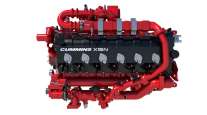Senior Reporter
Execs Make Case for Natural Gas Trucks

This story appears in the Sept. 26 print edition of Transport Topics.
Natural gas presents a practical case for wider use in the trucking industry, with improved range, predictable return on investment, support for energy independence and lower engine emissions, top business and trade association executives said Sept. 19.
“Natural gas is already the preferred and dominant alternative fuel in America’s trucking fleets, delivering low and stable pricing while reducing emissions,” said Chris Spear, president of American Trucking Associations. “Its abundant supply in the United States makes it a viable energy source for decades to come.”
The number of natural-gas fueling stations for over-the-road truck fleets continues to expand, according to experts, while waste management and public transit operations remain the prime users of the fuel.
Spear led a discussion on natural gas as a fuel in trucking during an ATA-sponsored webinar that featured FedEx Corp. Chairman, President and CEO Fred Smith; T. Boone Pickens, a billionaire investor in energy and transportation companies, including Clean Energy Fuels Corp. and truck maker Navistar Inc.; and Matthew Godlewski, president of the advocacy group Natural Gas Vehicles for America.
“We are opening up in Oklahoma City a state-of-the art compressed natural gas terminal for our FedEx Freight unit, which is our largest user of heavy trucks. Now this is no small thing,” Smith said.
Last year, the FedEx Freight and FedEx Ground units, combined, drove almost 3 billion miles in the United States, Smith said.
FedEx plans to open another CNG terminal soon in Texas, he said, and others are planned, “as long as the economics continue to make sense.”
FedEx ranks No. 2 on the Transport Topics Top 100 list of the largest U.S. and Canadian for-hire carriers.
Meanwhile, the heavy-duty trucking industry uses about 3 million barrels of diesel fuel a day, Smith said.
“Of the hydrocarbons, natural gas is considerably cleaner than diesel. It is more stable in price,” he said. “It is American-produced and is not nearly as volatile [as oil]. So those attributes of CNG for over-the-road fleets are very attractive and that is why we are putting the effort behind rolling out these CNG terminals.”
Pickens said the main impediment to greater use of natural gas in over-the-road trucking has been the limitation on a vehicle’s range.
“The range trucks could travel on a tank was a factor at one point, but not any longer. I think the impediments are clearing up and what is missing is leadership that FedEx will provide,” Pickens said.
“If FedEx does it, a lot of other truckers will accept it a lot quicker now than they did a few years ago when they might have first looked at it,” he said.
UPS Inc., which ranks No. 1 on the for-hire TT100, is another carrier that operates natural gas vehicles, as do a number of smaller regional carriers.
Godlewski said natural gas fuel tanks now weigh 40% less and are constructed to provide trucks with a range of 800 miles, compared with earlier designs that limited the range to about 450 miles.
The fuel system’s cryogenic tanks have come down in price, too, Smith added.
Separately, Godlewski supplied TT with NGV’s latest findings on the domestic expansion of natural- gas fueling stations.
The number of compressed natural gas fueling stations increased 9.5% year-to-date through July to 1,712 compared with 1,564 stations in the 2015 period. Public stations account for the larger share of the growth.
Liquefied natural-gas stations in the same year-to-date period increased to 145 compared with 112 a year earlier, a 29.9% increase, NGV said.
“The LNG growth is due to 14 stations opened by UPS, a number of Clean Energy stations that came online and a few corrections from stations that had been previously missed,” Godlewski said.
FedEx’s Smith also is co-chairman of the Energy Security Leadership Council. It is made up of business leaders and former senior military officers and advocates U.S. energy independence, reducing energy use through higher energy- efficiency standards and development of alternative fuels and energy sources such as natural-gas and batteries.
Simply put, most of the conflicts in the 20th century were essentially battles over oil, Smith said. And that is still lingering.
“The current dispute in the South China Sea with China [and neighboring countries] is largely over those lessons of World War II. They are oil importers. They want to make sure in any conflict they can’t be cut off from oil, which is the lifeblood of modern industrial society,” he said.




